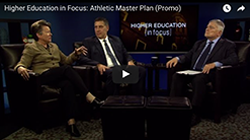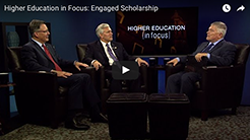The Value of Researcher-Writer Collaboration
This week, President Barron invited Lawrence Lokman, vice president for Strategic Communications, to share his thoughts on the value of researcher-writer collaboration in helping to turn research findings into actionable information for communities.
Today, more than 500 of the nation’s leading science writers, reporters, and editors are joining outstanding Penn State researchers for ScienceWriters 2019, co-organized by the National Association of Science Writers and the Council for the Advancement of Science Writing.
There has never been a more exciting time to be a science communicator. The digital sphere has provided tools and channels to reach and engage people everywhere, in an instant. On the content side, they can now employ the written word, photography, video, sound, graphics and animation. And with the click of a button, the information they create and package can span communities, societies and cultures like never before. This is a thrilling challenge, and opportunity that our science writers must approach with a child’s sense of wonder and curiosity.
Ranking among the top 25 U.S. research universities, Penn State is making a positive impact in Pennsylvania, the nation and the world. Every day, science communicators help turn our research findings into actionable information for communities. Media coverage exposes new discoveries, explains complex topics and facilitates productive dialogue around important issues.
My team is lucky to dedicate time to learning about exciting research across the University to bring attention to critical work. We are eager for Penn State experts to showcase their labs and share their thinking with the communicators here on campus for ScienceWriters 2019. Together, we’ll talk about topics ranging from coral systems to food security to alien life. We know that improving lives through research depends on our collaborative pursuits.
Translating Interdisciplinary Research
Penn State’s scientific community draws upon a diverse set of perspectives from many disciplines. The intricacies of cross-field work can be particularly challenging to distill into meaningful insights. For example, consider our research into mosquitoes that subject more than half the world’s population to the threat of dengue virus. To address virus transmission, our team has combined expertise from biology, entomology, infectious disease, genetics and bioinformatics.
We appreciate science communicators for digging into complicated subjects and making results accessible to the public. They are at the forefront of discussing and debating data and findings that affect so many. Through close collaboration, we can convey the full impact of these interdisciplinary efforts, strengthen partnerships and ultimately guide policy decisions and changes for the greater good.
Communicating Progress
Penn State tackles evolving global issues that require sustained commitment over time. Long-term research can be difficult at times to translate into messages of hope, meaning or outcomes. For example, consider our research into climate solutions that will keep our researchers, and many more, focused for years to come. To facilitate solutions, our scientific community recently brought experts together for the first international discussion on Project Drawdown’s proposed ideas.
We thank science communicators. They raise our expectations and open our eyes to critical research happening at every stage. Through sustained collaboration, we can provide context for progress, encourage further investment and foster international discourse.
A Nobel Laureate in chemistry once explained to me his moment of insight. I asked him what that felt like. He answered it was as if he had reached the top of a peak, only to discover, at that moment of accomplishment, the unexpected sight of an undiscovered and unexplored valley ahead of him. His eyes closed, and I could see he was imagining the valley ahead, and I realized, at that moment, that as communicators, we are fortunate to be able to help others understand how science advances the public good, and encourages the exploration of new frontiers. What a wonderful gift we have been given. We must use it well.
At the heart of great science storytelling are strong translational connections between researchers and writers, and writers and the public. In bringing science into people’s lives and generating engagement around cutting-edge research, we will continue to work together to mobilize the public, donors and policymakers toward more research and improved solutions, all with an eye toward creating a better world.
My unit, Strategic Communications here at Penn State, is so pleased to be bringing ScienceWriters 2019 to life on campus. To learn more about the conference: www.sciencewriters2019.org.




